|
Though
ungrammatical, it would not be out of place to say that the
legend of the Colt Buntline, the Buntline donation and Wyatt
Earp's association with a 12-inch barreled, .45 Colt Single
Action Army Revolver has been bunked, then debunked then
rebunked again. The oft- repeated story is that in 1878, Ned
Buntline, the dime novelist, ordered a batch of foot long
Colts and presented them to Wyatt Earp, Bill Tilghman, Bat
Masterson, Neal Brown and Charlie Bassett - all
lawmen in Dodge City. They fly in that ointment is the absence
of any record of such a transaction in the Colt archives.
This, combined with the absence of any surviving examples
and the general view that Buntline, Earp biographer Steward
Lake and Earp himself were but indifferent honest has cast
considerable doubt on the story.
In his book, Colt:
An American Legend, R.L. Wilson quotes a letter
found in the Colt papers that may redeem the legend to some
extent. One Buckskin Frank Leslie, a bartender in
Tombstone, wrote to Colt Patent Firearms early in 1881
requesting a revolver of superior finish, ivory gripped with
12-inch barrel along with belt and holster rig.
There is no documentation on whether the order was filled
or not but if so, it could have been in prominent display in
Tombstone months before the O.K. Corral fight. The order, filled
or not, may well have resulted from Buckskin Frank's observation
of just such a revolver in the hands of Earp.
In
the late 1950s, we all believed the legend. Hugh
O'Brian as Earp was clubbing drunks with a Buntline on a
weekly television show and Colt had reissued the Buntline in its
second generation production.
In 1959, the scaled down rimfire Buntline Scout came out
with its black anodized alloy frame and 9.5-inch barrel. The
Scout was my first revolver. My dad's reasoning in the choice
stemmed from two important considerations. Handgun shooting and hunting, while growing in popularity,
were totally illegal under Texas law.
Enforcement was often tied to reason and it seemed that
the police would be inclined to view the long revolver as a
sporting tool rather than a concealed weapon. The other factor
came from his belief that I might actually be able to hit
something with the long-barreled revolver. That was important
because, at that time, the Central Texas countryside supported
huntable populations of cottontails, jackrabbits and a huge
influx of armadillos from southern regions.
The sights of the Buntline Scout were in perfect register
and I did, in fact, bag a considerable number of the operant
fauna. The Buntline was much more shootable than the more
popular ejector rod length Frontier Scouts.
One time in the mid -sixties, the local gun club held a
turkey shoot. The rifle targets were the head and neck of live
turkeys at 100 yards and they set up a side match for rimfire
handguns. The
contestant had to bust four of five balloons at 25 yards and in
a second match, put three of five rounds into the black of a
fifty-yard rifle target at the same 25-yard distance.
I quickly racked up two dressed turkeys and handed the
Colt off to a friend who repeated the performance. They changed
the rules to keep that from happening again.
From that time forward, contestants would have to fire
the revolver from one hand and could only win one turkey.
I came back the next day and picked up another turkey
under the new rules.
The
Buntlines inspired quite a number of long-barreled,
adjustable-sighted sporting revolvers and then, in 1993, Tombstone
burst forth on the silver screen renewing a public demand for a
Buntline in the traditional configuration. By the end of the
decade, Cimarron Arms Company had conspired with the A.
Uberti plant to bring out the Earp Buntline. The Cimarron
product has a ten-inch barrel, black powder frame and the
traditional pre-1920 sights of the Cimarron "Model P"
line. Among the
Model P's, the flat, two- pronged trigger bolt spring is
retained but the leaf spring that drives the hand has been
replaced by a durable coil spring/plunger arrangement.
Broken trigger/ bolt springs are easy to replace and
obtainable through Cimarron Arms and VTI Gun Parts. The
traditional hand, hand springs are often replaced as a unit with
the hand requiring fitting.
The coil spring arrangement is much more user-friendly in
the long run.
Johnny
Bates' Buntline is perfectly timed. There is no end or side
play in the cylinder at rest or at full cock. This is the wished
for and often achieved situation with the Cimarron Model P and
Uberti single actions in general. It is not uncommon to find
these revolvers exhibiting fore and aft movement of the cylinder
or a carry-up timing issue where the bolt drops just short of
the lead to the cylinder notch. Ubertis as a rule, have ideal
chamber bore dimensions and relationships and are predictably
very accurate-even when the timing and cylinder/bushing fit fall
short of the ideal. The wood to metal fit and metal to metal fit
of this revolver is, typical of other Uberti products, extremely
precise. Polish and blue is flawless and the color case
treatment reasonably attractive though far short of the early
Colts and the current Doug Turnbull treatment. It is
possible to fall into a Cimarron/Uberti single action with
perfectly regulated sights. In the case of our sample Buntline,
the revolver hit about five inches left and low at 25 yards.
Bates applied some correction in the field by filing the rear
sight notch to the right and later brought the revolver into
near perfect register by using his homemade frame wrench to
minimally tighten the barrel. A feature shared amongst the
Uberti single actions is an over-tall front sight that allows
filing to achieve the proper elevation with a given ammo type.
Our
.45 Colt loading strategy is simple, straightforward and dull.
The single goal is to produce ammunition that launches the
available lead 250-260 grain lead bullets to the same velocity
as the smokeless powder loads available through most of the 20th
century or, somewhat faster than the current loads that show the
influence of the Cowboy Action
Shooting games.
| Load |
Gun / Barrel Length |
Velocity (fps) |
Velocity Spread |
Group Size (inches) |
| 260
Grain 454190 RNFP 7.5 Unique |
Cimarron Wyatt Earp Buntline / 10" |
935 |
43 |
NA |
| 260
Grain 454190 RNFP 7.5 Unique |
Ruger Vaquero / 4-3/4" |
845 |
86 |
NA |
| 253
Grain Meister Cast RNFP 7.5 Unique |
Cimarron Wyatt Earp Buntline / 10" |
873 |
57 |
1.4" / 25 yds. |
| 253
Grain Meister Cast RNFP 7.5 Unique |
(Fast) Uberti Pre-War / 4-3/4" |
866 |
35 |
NA |
| Hornady
.454 RNFP Swaged 5.5 TiteGroup |
Cimarron Wyatt Earp Buntline / 10" |
816 |
29 |
1.5" / 25 yds. |
| Hornady
.454 RNFP Swaged 5.5 TiteGroup |
(Fast) Uberti Pre-War / 4-3/4" |
800 |
NA |
NA |
Early
on, with the sights still at factory register, Bates asked me to
shoot a five-round, one handed group at 25 yards.
I selected a corner of the target board, guessed at
elevation and produced a centered 3.7" spread. The trigger,
after perceptible creep, broke at about 4.5 guessed-at pounds
with the long barrel providing the expected training wheels
function. Further off-hand shooting, even with the necessary
bias in the sight picture, danced empty vegetable cans with
gratifying regularity. The handling qualities and profile of the
sight picture of these Cimarron/Uberti replicas is so close to
the first generation Colts that there is virtually no difference
in the sensation when firing them back to back. The chamber to
barrel dimensions of the Ubertis usually provide a distinct
accuracy advantage even with such second tier cartridges as the
32 through 44 WCFs. The .45 Colt is a gentle round
notwithstanding the barrel whip apparent in the pictures.
Legend
has it that, among the lawmen who received the Buntline Colts,
only Earp kept his in the original form. The others allegedly
whacked the barrel to ejector rod length for convenient holster
carry. One of the early handloading manuals - one that I can't
seem to find right now - used a chopped Second Generation
Buntline to derive performance data.
Bates himself had Peacemaker Specialists swap his
Second Gen. Buntline barrel for a 4 3/4-inch. Portability aside,
whether the shooter is a casual plinker or sometimes varmint
hunter, when down-range results outweigh convenience, the
Buntlines definitely earn their place in the Sun.
Mike
Cumpston
|

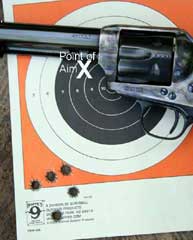
At
25 yards from the bench, our first serious effort at a group,
after initial sight adjustment established that the Earp
Buntline hit low and still a bit to the left.
The 1.4-inch group is fairly representative of the
accuracy we were able to demonstrate and is quite good for a
Single Action Army regardless of manufacture. The load is the
Meister Round Nose Flat Point "Cowboy Action" Bullet
over 7.5 grains of the current Alliant Unique.
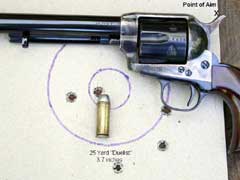
An
impromptu "Duelist" group from 25 yards before any
sight regulation took place. The point of aim is as indicated
on the picture.
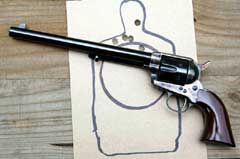

Bates
regulated the point of impact using a file and improvised
barrel wrench. Sight
regulation of the Cimarron/ Uberti revolvers mimic the early
Colts in this respect. The
point of aim is often only an approximation of the actual
point of impact. Since direction of movement of the front
sight is opposite of the point of impact shift, it is helpful
if the revolver hits low and left.
It is frequently possible to adjust left windage by
screwing the barrel in a bit while carefully filing the front
sight raises the group.
|
  
Got something to say about this article? Want to agree (or
disagree) with it? Click the following link to go to the GUNBlast Feedback Page.
|
|
Click pictures for a larger version.
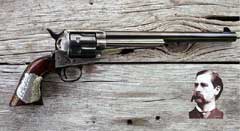
The
Cimarron/ Uberti Earp Buntline came about at the end of the
1990s as a result of the successful film,
"Tombstone." Colt
Buntlines of the Second Generation, were an offshoot of the
"Life and Legend of Wyatt Earp as interpreted by Hugh
O'Brian on the small screen. In the face of such legendary
roots, the practicalities of these revolvers are often
overlooked.
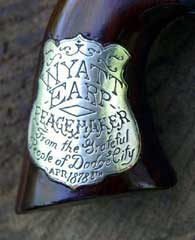
Printing
the Legend.
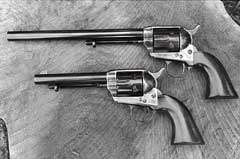
Cimarron
revolvers bear correct patent dates on the frame, the Cimarron
address line appears on the top of the barrel as is the case
with first generation Colts and Italian proof marks are hidden
on the bottom of barrel or frame front. The Buntline and the
"Model P" 32-20, by virtue of ideal chamber/throat
dimensions, reliably produce groups in the one inch range from
the bench at 25 yards. Out of the box, windage was close to
ideal and filing the front sight raised the point of impact.
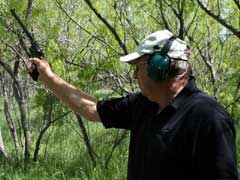
Bruce
Fletcher, a Bates cousin, takes up a new and expensive
hobby.
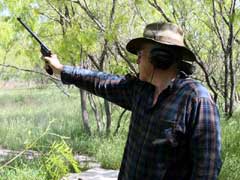
Cumpston
learned to shoot with a Colt Buntline Scout. In spite of the
obvious barrel rise, the .45 Colt in standard loadings is very
gentle. The Earp
Buntline and other representatives of the original Colt
Single Action are definitely NOT SAFE with the high
pressure loads currently in common use in the Ruger Blackhawks
and custom revolvers.
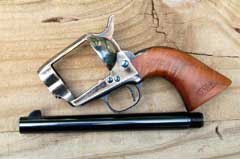
This
Cavalry model came with the front sight and address line
cocked visibly to the right. The barrel is so tight that
actual gunsmithing will be necessary to turn it enough to
regulate the sights.
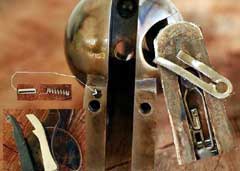
The
Cimarron Model P has a spring plunger hand spring
power train replacing the potentially fragile and
tedious to replace traditional leaf spring.
Some Ubertis also have round wire trigger/bolt springs
which are usually more durable than the older flatware
(picture right) The Model P uses the flat two-leafed spring
but replacing it with the wire spring often lightens the
trigger pull to a useful degree.
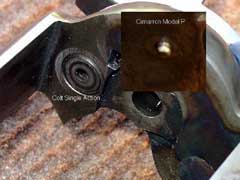
Original
Colts, USFA Single Action Armies and some Ubertis have a
removable firing pin bushing in the frame.
This is a desirable feature because the firing pin hole
tends to enlarge and allow primer flow
to interfer with cycling.
Since the Buntline and other Cimarron Model Ps do not
have a removable bushing, it is important to avoid uncushioned
dry firing in order to prevent or at least delay wear to the
firing pin hole.

While
many modern Single actions have solid base cylinder/base pin
bushings, the model P retains the removable one of the
original Colt first and second generations. A replacement
bushing can be quickly fitted to eliminate cylinder end float
should it occur secondary to wear.
My 32 WCF came from the factory with perceptible end
shake. I removed
it by lightly peening the tip of the bushing at the arrow.

There
is now a bewildering array of variations in the Model P line.
The buntline is available in standard finish or the
aged "Original" finish.
The bottom revolver is a variation on the old
"Sheriff's Model"/"Storekeeper" differing
from historical arms in that it has an ejector assembly.
|
![]()